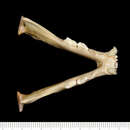Biology
(
Inglês
)
fornecido por Arkive
Stalking though the thick vegetation of its forest habitat, this secretive predator feeds on a variety of birds, including domestic geese and chickens, and also consumes rodents and small lizards (2) (4). Although it hunts its prey on the ground, the kodkod is an excellent climber (2), and will climb trees when escaping the pursuit of a predator or to take temporary shelter in the branches (4).
The kodkod is primarily a nocturnal cat, although it can also be active during the day (2) (4), and it spends its periods of rest in dense vegetation, often hidden amongst almost impenetrable bamboo (2).
Male kodkods occupy large areas, which overlap the smaller ranges of one or more females (2). Female kodkods give birth to litters of one to four young, after a gestation of 72 to 78 days. These small cats are thought to live for up to 11 years (4).
Conservation
(
Inglês
)
fornecido por Arkive
The kodkod is fully protected in Argentina and Chile, and also occurs in a number of protected areas including Nahuel Huapi National Park in Argentina (4) and Nahuelbuta National Park in Chile (5).
Description
(
Inglês
)
fornecido por Arkive
This secretive cat is the size of a tiny house cat, earning itself the distinction of being one of the smallest cats in the southern hemisphere, joined only by the oncilla (Leopardus tigrinus) (2). Its diminutive body is covered with buff to greyish-brown fur, heavily patterned with small black spots that sometimes form broken streaks on the head and neck (2) (4). Its small head bears low-set ears, the backs of which are black with a white spot in the centre. The short tail is bushy and marked with narrow, black bands (2), and the rather large feet hint at this cat's proficient climbing abilities (4).
Habitat
(
Inglês
)
fornecido por Arkive
A forest-dwelling cat, the kodkod inhabits the moist, montane forests of the southern Andes, generally at elevations below 2,000 metres (2) (4).
Range
(
Inglês
)
fornecido por Arkive
The kodkod is found only in Chile and Argentina. It occurs in the central and southern regions of Chile, including the islands of Chiloé and the Guaitecas Archipelago, and in a small region on the eastern slopes of the Andes in Argentina (2).
Status
(
Inglês
)
fornecido por Arkive
Classified as Vulnerable (VU) on the IUCN Red List 2007 (1) and listed on Appendix II of CITES (3).
Threats
(
Inglês
)
fornecido por Arkive
The kodkod is most threatened in central Chile, where forest habitat has been cleared for agriculture and logging, resulting in a decline in kodkod numbers (4). Elsewhere, the kodkod's habitat is less threatened; for example, the forests in the southern part of its range are well protected and less inhabited by humans (4). However, hunting poses a threat in all areas. Fur of the kodkod has been seen for sale in local markets and in some areas the kodkod may be killed in the belief it attacks poultry and livestock (2).

